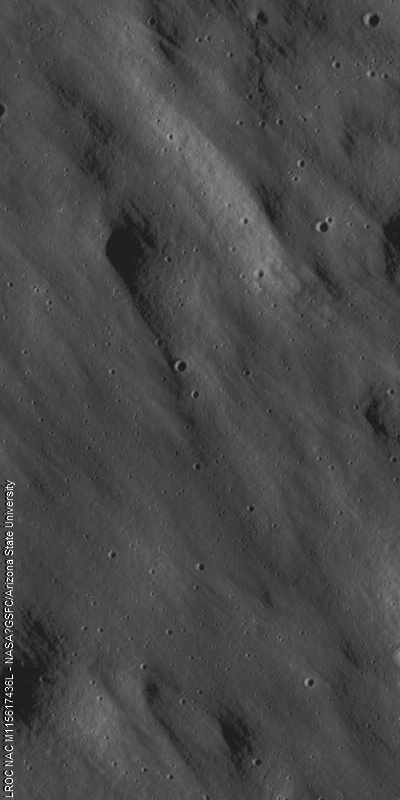Pan of the LROC Featured Image released November 22, 2010 - Narrow Angle Camera (NAC) view of the "Far edge of the Giordano Bruno crater ejecta blanket." LROC NAC observation M115617436L, LRO orbit 2172, December 16, 2009; resolution 0.9 m/pixel, image field of view is 1.08 kilometer, the Sun's illumination is from the right. See the full-size original LROC Featured Image HERE. The famous young crater Giordano Bruno is to the northwest [NASA/GSFC/Arizona State University].
Hiroyuki Sato
LROC News System
Impact cratering is a common and universal phenomena on every planet and satellite. However, we still do not completely understand this complicated process. The Moon is one of the best libraries of impact craters in our Solar System because its surface is not modified by atmospheric weathering or water erosion. The dominant form of erosion on the Moon is indeed impact cratering.
Full resolution (86 centimeters per pixel) close-up of LROC NAC observation M115617436L showing how the Giordano Bruno ejecta blanket scoured and partially erased the terrain it channeled and buried. The pattern is reminiscent of the "elephant skin" pattern characteristic of nearly all older lunar surfaces higher than surrounding elevations [NASA/GSFC/Arizona State University].
Today's featured image shows the edge of the Giordano Bruno crater ejecta (35.94°N, 102.91°E); upper-left of the WAC image (below). Here you can easily see the delicate patterns of ejecta overlying pre-existing terrain. The ejecta pattern points back to the crater, and gives the impression of a fast moving surface flow. Combining the morphology of the ejecta, and new topographic data from NAC stereo pairs, scientists will be better equipped to unravel the physics of ejecta emplacement.
Context map around Giordano Bruno crater (centered 107°E, 34°N). LROC WAC 100 m/p monochrome mosaic overlayed by optical maturity (OMAT) parameter [Lucey et al, 2000], generated from Clementine Ultra-Violet/Visible wavelength (UVVIS) data, at 200 m/p. Blue corresponds to younger, "optically immature" material, and red is an older and more mature surface. The white dashed box corresponds to the footprint of the full LROC NAC observation from which the LROC Featured Image released November 22, 2010 was taken . See the full-resolution original of the above HERE [NASA/GSFC/Arizona State University].
Zooming in upon Giordano Bruno, using the LROC Planetary Data Base (PDS) Image Search interface now vastly improved with the new Wide Angle Camera (WAC) global mosaics, quickly unveils the brighter low OMAT influence the young crater's impact event has had on its surroundings, just beyond line-of-sight view from Earth past the Moon's eastern limb [NASA/GSFC/Arizona State University].
Explore the Giordano Bruno ejecta blanket NAC frame!
Reference: Lucey et al. (2000) JGR, v105, no. E8, p.20377-20386.
Previous post showing the floor of Giordano Bruno.




